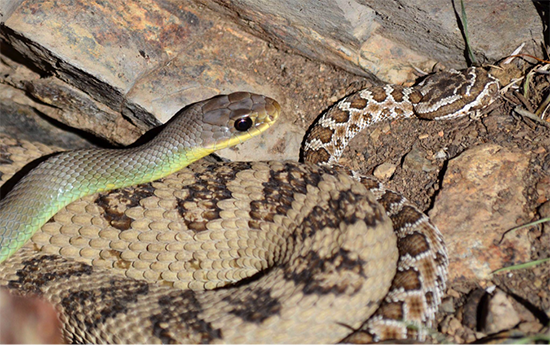BY LARRY BARNES
Idaho rattlesnakes are emerging from their winter’s sleep to some unpleasant new rules enacted by their human overlords. The serpents had spent the previous six months deep within their dens in companionable tangles, their hearts beating slowly, their metabolisms at rest in stable darkness, and their bodies warmed slightly by the earth. Here, Idaho’s rattlesnakes were safe from the killing cold just feet above them as they had been for millions of previous winters.
But on Earth’s surface Idaho legislators passed House Bill 156, the rattlesnake killing bill, which was signed by the governor on March 24, 2023. Previously, an Idaho hunting license entitled one to legally kill four rattlesnakes annually and even sell their skins, as hat bands, for example. But now, there shall be no limits. Counsel from the scientifically literate at the Idaho Department of Fish and Game was ignored (or not sought).
A senate sponsor of the bill, Cindy Carlon, explained that where she lives, in Riggins, “Idaho’s people need the ability to kill them without the threat of a fine” and that “this legislation removes the prohibition on killing rattlesnakes.” The two representatives that introduced the bill saw a need to make it legal for any Idahoan with a hunting license to kill as many rattlesnakes as they like.
We can assume that these politicians never had a class in ecology, and if they did, it made no sense to them. The Great Basin rattlesnake (Crotalus lutosus) is our only local venomous snake species. Compared to cars and guns, Idaho’s rattlesnakes are harmless; we don’t die when bitten by one and the few people that are bitten annually are usually messing with them. Veterinarians treat dogs bitten by rattlesnakes with antibiotics and send them home.
But as predators of small rodents, snakes are a force in our ecosystems. They unobtrusively spend half the year roaming the lands around their den site, ambushing small rodents with a lethal bite. Using their forked tongues, they follow the scent trail to its end, where the energy in their prey becomes energy to the snake. Males range up to 2.5 miles from their den in their search for mating opportunities. During their quest for food and mates, the snakes must avoid predators, like badgers, and the scourge to all snakes: roads and wheeled vehicles.
The rattlesnakes’ plodding ways are mirrored in their biology. Females don’t give birth until they are 5-7 years old, when they produce only 5-10 babies in late summer. Giving birth uses so much energy that another 3-5 years may lapse before giving birth again. Their low fecundity is partially compensated for by their long lives — up to 25 years.
Before the rattlesnakes’ spring dispersal and fall return, they are vulnerable as they lounge together near their den’s entrance, moving between shade and sun to achieve optimal body temperatures. As night approaches, they retreat to their dens to escape the coming cold, emerging in the morning as the sun warms the land. Some dens offer winter refuge to hundreds of snakes and now it will be legal for one person to kill them all, turn them into hat bands, and end the ecological services the snakes provide as predators to rodents.
The sun has rained its energy down on Earth for 4.6 billion years, resulting in the food webs, trophic pyramids, and rococo exuberance of today’s natural world. We are all in the mix, humans to rattlesnakes, and all have a role in this beautifully tangled web of ecological interactions. Some humans, however, are asleep at the wheel and recklessly hack away at the fabric of life when they don’t understand it.
Larry Barnes retired from 26 years as a biology teacher at Wood River High School and is now transitioning to spending more time exploring the natural world.



